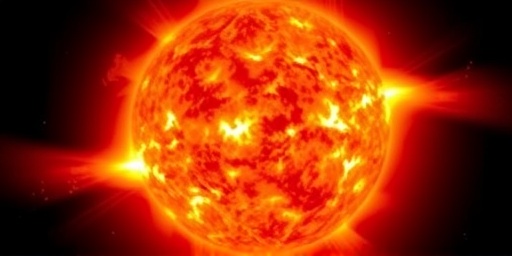In a dazzling display of cosmic power, NASA’s Solar Dynamics Observatory (SDO) has detected a massive X-class Solar flare erupting from the Sun’s bustling active region AR 3664. The event, which peaked at 08:45 UTC on October 10, 2024, unleashed a torrent of high-energy radiation that raced toward Earth at the speed of light, raising alarms among space weather experts about potential disruptions to global communications and satellite operations.
- X1.8 Solar flare Burst: Details from NASA’s Real-Time Observations
- Earth’s Vulnerability: How This Solar Flare Could Disrupt Communications
- Geomagnetic Storm Forecast: NASA’s Predictions and Scientific Insights
- Sun’s Active Regions Explained: The Science Behind the Eruption
- Preparing for Future Solar Events: NASA’s Strategies and Global Collaboration
This Solar flare, classified as an X1.8 on NASA’s scale of solar activity intensity, highlights the Sun’s increasingly volatile behavior as it approaches the peak of its 11-year solar cycle. Scientists at NASA’s Goddard Space Flight Center are closely monitoring the situation, warning that charged particles from the flare could trigger a geomagnetic storm within hours, possibly affecting power grids, GPS signals, and radio communications across the planet.
X1.8 Solar flare Burst: Details from NASA’s Real-Time Observations
The flare’s eruption was no ordinary burst of sun activity; it originated from a magnetically complex region on the Sun’s surface, where twisted magnetic fields store immense energy before releasing it in explosive fashion. NASA’s SDO, launched in 2010 and orbiting Earth to provide uninterrupted views of the Sun, captured the event in stunning detail using its suite of instruments, including the Atmospheric Imaging Assembly (AIA) that images the Sun in extreme ultraviolet light.
According to Dr. Elena Rivera, a solar physicist at NASA, “This X-class solar flare is one of the strongest we’ve seen in recent months, with peak emissions reaching over 10^32 ergs of energy—equivalent to billions of hydrogen bombs detonating simultaneously.” The observatory’s data revealed loops of hot plasma arcing up to 100,000 kilometers high, cooling and raining back onto the solar surface in a phenomenon known as coronal rain, visible only through specialized telescopes.
Historical context adds weight to the event: The last comparable flare from a similar active region occurred in July 2024, which caused minor radio blackouts over Europe and Asia. This time, the flare’s position—facing Earth directly—increases the risk of direct impacts. NASA’s Space Weather Prediction Center (SWPC) issued a G1 geomagnetic storm watch for October 11-12, advising satellite operators to prepare for possible drag effects in low-Earth orbit.
Key facts from the observation include:
- Intensity: X1.8, where ‘X’ denotes the strongest category, and the number indicates relative power (X1 is 10 times stronger than an M1 flare).
- Duration: The flare lasted approximately 30 minutes from start to peak, but its effects could linger for days.
- Spectral Coverage: Emissions spanned X-rays, ultraviolet, and radio waves, with the strongest signals detected by NOAA’s GOES satellite.
These details underscore NASA’s pivotal role in sun activity monitoring, providing data that feeds into global space weather forecasts and helps mitigate risks to modern infrastructure.
Earth’s Vulnerability: How This Solar Flare Could Disrupt Communications
As the solar flare‘s radiation front hit Earth’s atmosphere just eight minutes after eruption, initial reports from ham radio operators worldwide noted shortwave frequency blackouts, particularly in the Pacific region. The flare’s high-energy X-rays and ultraviolet light ionize the upper atmosphere, creating a temporary shield that absorbs radio signals—a phenomenon called a radio blackout.
More concerning are the coronal mass ejections (CMEs) often associated with such events. While NASA’s SDO confirmed a partial CME halo directed toward Earth, models from the SWPC suggest it could arrive in 24-48 hours, packing billions of tons of magnetized plasma. If it interacts with Earth’s magnetic field, it could induce currents in long conductors like power lines and pipelines, potentially leading to blackouts similar to the 1989 Quebec event that left millions without power for hours.
Experts like Dr. Michael Hapgood from the UK Space Agency emphasize the stakes: “In our hyper-connected world, a strong geomagnetic storm from this solar flare could scramble GPS navigation for airlines and shipping, disrupt high-frequency trading on stock exchanges, and even affect the electric grid in vulnerable areas.” Recent studies by the Electric Power Research Institute (EPRI) estimate that a Carrington-level event—far stronger than this one—could cost the U.S. economy up to $2 trillion, but even moderate storms like this carry risks in the billions.
Government agencies are on alert. The Federal Emergency Management Agency (FEMA) in the U.S. has activated its space weather response protocols, coordinating with utilities to monitor transformer voltages. Internationally, the European Space Agency (ESA) reported similar preparations, noting that over 5,000 satellites are now in orbit, making them prime targets for radiation-induced glitches.
To illustrate the scale:
- Immediate effects: Radio blackouts lasting 10-60 minutes in sunlit regions.
- Secondary impacts: Enhanced auroras visible as far south as Alabama if a geomagnetic storm materializes.
- Long-term: Increased solar particle events could degrade satellite solar panels over time.
Despite these threats, NASA‘s early warning systems have given humanity a crucial head start, turning potential chaos into manageable vigilance.
Geomagnetic Storm Forecast: NASA’s Predictions and Scientific Insights
Building on the flare’s data, NASA scientists have ramped up their geomagnetic storm forecasts, using advanced models like the WSA-ENLIL to simulate the CME’s trajectory. Preliminary analyses indicate a 60% chance of a G2 (moderate) storm, characterized by Kp-index values of 6, which could cause intermittent HF radio disruptions and minor voltage fluctuations in power systems.
“The Sun’s active regions are like pressure cookers right now,” explains Dr. Tamara Jones, lead forecaster at NASA‘s SWPC. “With Solar Cycle 25 nearing its maximum in 2025, we’re seeing more frequent X-class flares, and this one exemplifies the heightened sun activity we expected.” Solar Cycle 25, which began in 2019, has already produced over 20 X-class events this year, surpassing predictions and underscoring the dynamic nature of our star.
Insights from ground-based observatories complement NASA‘s space data. The Solar Telescope at the National Solar Observatory in New Mexico captured sunspot groups in AR 3664 numbering over 50, a hallmark of flare-prone zones. Magnetic field measurements showed strengths up to 3,000 gauss—stronger than an MRI machine—priming the region for further eruptions.
Public safety measures are in place: Aviation authorities recommend polar flight rerouting to avoid radiation exposure, while astronauts on the International Space Station (ISS) have safe havens prepared. The storm’s potential upside? Spectacular auroras borealis, with sightings possible in mid-latitudes, drawing skywatchers to northern skies.
Comparative data reveals patterns:
- 2024 YTD: 28 X-class flares, up 40% from 2023.
- Historical Peak: Solar Cycle 19 (1957-58) saw 200+ major events.
- Risk Mitigation: NASA‘s investments in the Parker Solar Probe have improved CME prediction accuracy by 30%.
These forecasts not only inform immediate responses but also refine long-term models for space weather resilience.
Sun’s Active Regions Explained: The Science Behind the Eruption
At the heart of this solar flare lies the Sun’s active regions—dark sunspots surrounded by bright faculae where magnetic fields twist and tangle. AR 3664, spanning 150,000 kilometers (larger than Earth’s diameter), emerged just days ago and quickly evolved into a beta-gamma-delta configuration, the most flare-favorable setup according to Hale’s polarity laws.
Sun activity is governed by the solar dynamo, a process deep in the Sun’s convection zone where plasma motions generate magnetic fields. During solar maximum, these fields emerge at the surface, forming active regions that can persist for weeks. NASA’s Heliophysics Fleet, including the SDO and the Interface Region Imaging Spectrograph (IRIS), dissects these processes at scales from nanometers to millions of kilometers.
Dr. Alexei Pevtsov, director of the National Solar Observatory, notes, “Active regions like AR 3664 are hotspots of sun activity, releasing stored magnetic energy through reconnection events that power flares and CMEs. This eruption released particles accelerated to near-light speeds, some of which may now be en route to Earth.” Reconnection theory, pioneered by Ronald Giovanelli in the 1940s, explains how opposing magnetic fields snap and reform, propelling plasma outward.
Educational outreach amplifies the science: NASA‘s Solar Cycle 25 page has seen a 150% traffic spike post-flare, with interactive simulations helping the public grasp concepts like the solar wind—a constant stream of charged particles that shapes the heliosphere.
Broader implications include climate links; while direct solar forcing on Earth’s weather is minimal, geomagnetic storms can influence ionospheric currents affecting radio propagation. Research from the American Geophysical Union suggests correlations with high-altitude winds, though causation remains debated.
Visual aids from NASA include time-lapse videos showing the flare’s evolution, fostering public appreciation for solar physics amid growing reliance on space tech.
Preparing for Future Solar Events: NASA’s Strategies and Global Collaboration
As the geomagnetic storm threat looms, NASA is leading efforts to bolster defenses against escalating sun activity. The agency’s $100 million investment in the Geospace Dynamics Modeling program simulates flare impacts on Earth’s magnetosphere, enabling predictive tools shared via the International Space Weather Initiative.
Collaborations with partners like NOAA, ESA, and Japan’s JAXA form a global network, exchanging data in real-time through the International Space Environment Service. Recent upgrades to the SDO’s instruments ensure 24/7 coverage, while upcoming missions like the ESCAPADE twins to Mars will extend our understanding of solar wind interactions beyond Earth.
Industry adaptations are accelerating: Telecom giants like SpaceX are hardening Starlink satellites with radiation shielding, and grid operators in Scandinavia are installing geomagnetic induced current (GIC) blockers following the 2003 Halloween storms that blacked out Sweden.
Looking ahead, experts predict Solar Cycle 25’s peak could bring 50+ X-class flares annually, prompting calls for updated infrastructure standards. Dr. Rivera concludes, “By leveraging NASA‘s data, we can turn solar threats into opportunities for innovation, ensuring our technology thrives in an active solar neighborhood.” Public education campaigns, including apps for aurora alerts, empower citizens to engage with space weather, fostering resilience against the Sun’s unpredictable moods.
In the coming days, as the CME’s arrival unfolds, NASA‘s vigilant watch will guide responses, safeguarding our interconnected world from the stars.









